#weizman institute
Explore tagged Tumblr posts
Text
by Martin Kramer
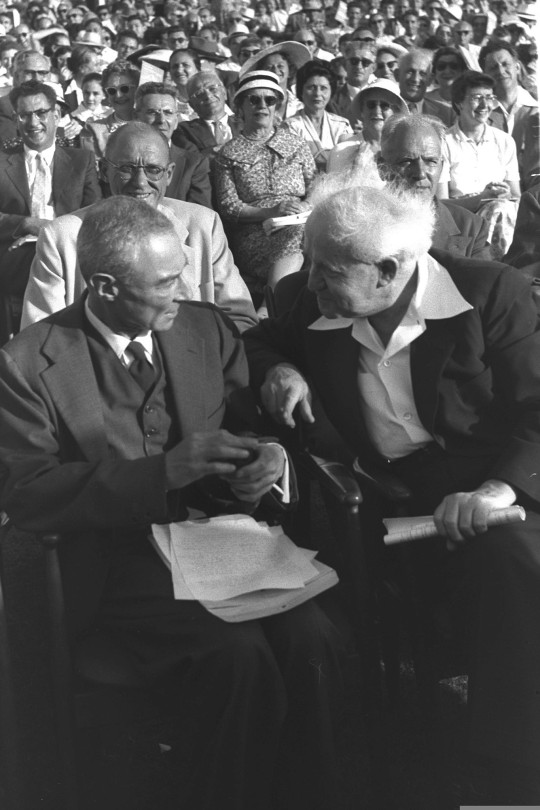
The text may help to explain a remark made by Israeli prime minister David Ben-Gurion to the Israeli cabinet, after he’d met with Oppenheimer at the latter’s request. Ben-Gurion said he “had the impression that some sort of Jewish spark lit up the man.”
That impression may have originated in Oppenheimer’s speech. Ben-Gurion certainly heard it. The prime minister delivered the keynote at the same dedication, and sat with Oppenheimer in the front row. Oppenheimer, in his own speech, made several references to Ben-Gurion’s remarks. (When Oppenheimer said “It is not only the Prime Minister of Israel who has his difficulties,” he was referring to Ben-Gurion’s admission that he didn’t understand much about physics.)
What’s the source for Oppenheimer’s text? Oppenheimer spoke from notes, but he didn’t have a copy of the speech as he delivered it. “I gave my notes on the ceremonial talk to your press officer,” he wrote to Meyer Weisgal, his host, “and have no record at all of what I said.” At Oppenheimer’s request, the Weizmann Institute sent him a tape with the extract of his speech, secured from the Voice of Israel, which had broadcast the proceedings. The following text is a transcription of the delivered speech, from Oppenheimer’s papers. While the Jerusalem Post reported a few portions of his remarks the day after he spoke, the speech is published here in full for the first time.
I’ve appended an extract from another speech that Oppenheimer gave for the Weizmann Institute on December 2, 1958, at its annual fundraiser at the Waldorf-Astoria Hotel in New York. There Oppenheimer reflected on his visit to Israel the previous May. It complements the Rehovot speech.
Some of the persons mentioned by Oppenheimer in the two speeches:
Niels Bohr, Danish physicist and 1922 Nobel laureate. Although baptized a Lutheran, his mother came from a distinguished Jewish family, so he fled Denmark during the Nazi occupation. He later assisted Oppenheimer in the Manhattan Project. Bohr had already lent his prestige to the Weizmann Institute during an earlier visit in 1953, and he also spoke at the 1958 dedication, for which the Institute commissioned his bust.
Meyer Weisgal, Zionist author and fundraiser, and confidant of the late Chaim Weizmann. At this time, he was chairman of the executive council of the Weizmann Institute. He would become the person in Israel closest to Oppenheimer.
Benjamin Bloch, physicist by training, administrator of the Weizmann Institute, and a friend of Bohr and Oppenheimer. (Felix Bloch, the Swiss-American physicist and 1952 Nobel laureate, also attended the 1958 dedication, but Oppenheimer’s reference to “Dr. Bloch” clearly refers to Benjamin.)
Abba Eban, Israeli statesman. In late 1958, he was at the end of his service as Israeli ambassador to the United States and chief delegate to the United Nations, and had been named the next president of the Weizmann Institute.
Ernest (later Lord) Rutherford, New Zealand-British physicist and 1908 Nobel laureate, a friend to Chaim Weizmann in Manchester.
20 notes
·
View notes
Text
Following Israel’s occupation in 1967, the government established settlements between the main Palestinian population centres in Gaza itself. The largest was Gush Katif, near Rafah on the Egyptian border; in total, Israeli colonies covered 20 per cent of Gaza’s territory. In the early 1980s the area in and around Gaza also absorbed many Israeli settlers evacuated from Sinai after the peace accord with Egypt. The first fence around the territory was built between 1994 and 1996 – a time seen as the height of the ‘peace process’. Gaza was now being isolated from the rest of the world. When, in response to Palestinian resistance, Israel’s Gaza colonies were dismantled in 2005, some of the evacuees chose to relocate to settlements close to Gaza’s borders. A second, more advanced fencing system was completed shortly after. In 2007, a year after Hamas took power in Gaza, Israel began its full-scale siege, controlling and limiting incoming flows of life-sustaining provisions such as food, medicine, electricity and petrol. The Israeli army calibrates the privation to a level that brings life in Gaza to an almost complete standstill. Together with a series of bombing campaigns, which according to the UN resulted in 3500 Palestinian deaths between 2008 and September this year, the siege has brought humanitarian disaster on an unprecedented scale: civil institutions, hospitals, water and hygiene systems are barely able to function, with electricity available for only around half the day. Almost half of Gaza’s population is unemployed and more than 80 per cent rely on aid to meet basic needs.
Eyal Weizman, Exchange Rate
54 notes
·
View notes
Text
------------------------------------------------------------------------------
Classification: There is a division of "us" v. "them," often carried out using stereotypes or excluding people perceived as different.
------------------------------------------------------------------------------



------------------------------------------------------------------------------
Dehumanization: Those who are perceived as "different" are treated with no form of compassion or personal dignity. Dominant groups will refer to affected groups as "animals," "inhuman," or "vermin."
------------------------------------------------------------------------------



------------------------------------------------------------------------------
Discrimination: The dominant group denies civil rights and even citizenship to identified groups.
------------------------------------------------------------------------------



------------------------------------------------------------------------------
Polarization: Propaganda begins to incite messages of hate or fear about those perceived as "different."
------------------------------------------------------------------------------




------------------------------------------------------------------------------
Symbolization: A visual manifestation of hatred, often forcing an "othered" group to wear or carry a marker to show they're "different."
------------------------------------------------------------------------------



------------------------------------------------------------------------------
Organization: Genocide is always planned. The perpetrators are trained and armed, often by the state or state actors. They begin to build up armies and stock weapons.
------------------------------------------------------------------------------


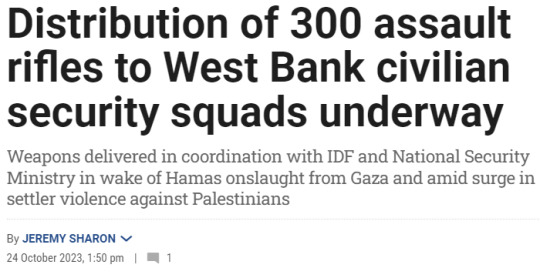

------------------------------------------------------------------------------
Preparation: Perpetrators plan the genocide. They will have organized, institutional plans to kill and will cloak it with euphemisms.
------------------------------------------------------------------------------

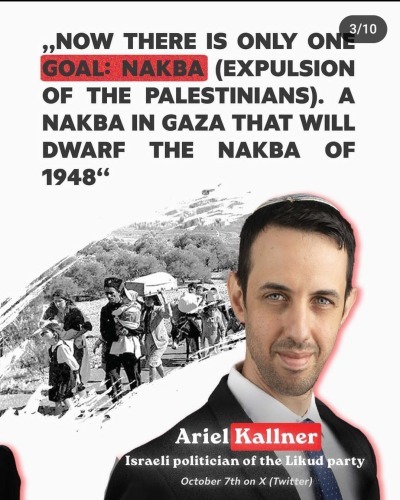
------------------------------------------------------------------------------
Persecution: Victims are singled out because of their ethnicity or religion, and death lists are drawn up. People are sometimes segregated into ghettos, deported or starved, and property is often expropriated. Massacres begin.
------------------------------------------------------------------------------

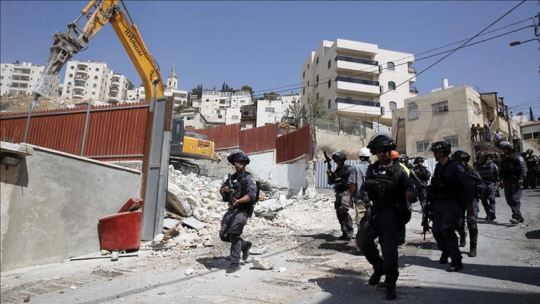
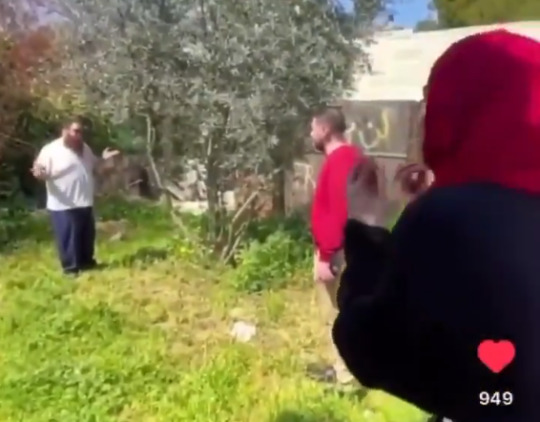





------------------------------------------------------------------------------
Extermination: The hate group murders its identified victims in a deliberate and systematic campaign of violence.
------------------------------------------------------------------------------
4 notes
·
View notes
Text
‘German officials,’ the New York Times reported – belatedly – in early December, ‘have been combing through social media posts and open letters, some going back over a decade.’ State-funded cultural institutions have long penalised artists and intellectuals of Global South ancestry who show any hint of sympathy for Palestinians, retracting awards and invitations; the German authorities are now seeking to discipline even Jewish writers, artists and activists. Candice Breitz, Deborah Feldman and Masha Gessen are just the latest to be ‘lectured’, as Eyal Weizman put it, ‘by the children and grandchildren of the perpetrators who murdered our families and who now dare to tell us that we are antisemitic’.
2 notes
·
View notes
Text
Weizman’s special talent in chemistry got revealed when he went to Germany and got admitted at the Polytechnic Institute of Darmstadt. Later he went to Switzerland and became a part of the University of Freiburg. The man who later displayed a successful political career was primarily engrossed with his studies at the earlier part of his life. Weizmann was awarded the doctorate in Chemistry in 1899 and two years later joined university of Geneva as an assistant lecturer. His excellence in chemistry was doing wonders in his career as in three years of time he joined University of Manchester as a senior lecturer. In personal life Chaim Weizmann was married to Vera Weizmann and the loving couple had two sons. Tragedy struck the Weizmann family when their younger son who was by profession a pilot of a fighter plane was shot down while flying and succumbed to the accident (Krane). Before discussing the political career of this great achiever, it is worth providing little more attention towards Weizmann the chemist. As mentioned earlier that he has moved to University of Manchester as a senior lecturer in chemistry in 1904. In 1910 he took British nationality and being a part of the Manchester University discovered how bacterial fermentation can be used to desired level to produce the determined level of similar substances. Weizmann is highly regarded as the father of industrial fermentation. The Weizmann organism or Clostridium acetobutylicum bacteria produced acetone within laboratory framework that later became important fuelling Allied war efforts (Dixon, 53). If he had contributed through the commercial production of acetone during the First World War, during the Second he got busy with synthetic rubber and high octane gasoline. Weizmann was highly regarded in England as one of the forefront chemists of his time and both during the First and Second Great War adorned with honorary posts to the British Military. Chaim Weizmann no doubt was an active chemist who had extended his helping hands towards the allied force during the First and Second Great War; yet at heart he was a strong believer in peace and considered science as the harbinger of the same “I feel sure that science will bring to this land both peace and a renewal of its youth, creating here the springs of a new spiritual and material life. And here I speak of science for its own sake and applied science.” (Spender 4) The academic and political career of this great soul ran on simultaneous track. While in Manchester he became a prominent Zionist leader and a regular attendee at the Zionist conferences. Weizmann is credited to have convinced the then British foreign minister Balfour (Balfour Declaration) on setting a Jewish homeland at Palestine, which was the long cherished Zionist demand. The man who later became the first President of Israel visited Palestine for the first time in 1907 (Isseroff). Though he was one of the founding members of the Palestine Land Development Company yet his inherent leadership and upright nature gets reflected through these words “A state cannot be created by decree but by the forces of a people and in the course of generations. Even if all the governments of the world gave us a country it would only be a gift of words. But if the Jewish people will go and build Palestine, the Jewish State will become a reality—a fact.” (Weizmann and Litvinoff, 301) Weizmann like a true leader had also tried to maintain a Read the full article
0 notes
Text
The newspaper’s publisher, Dietmar Koschmeider, told Drop Site that police were monitoring the event for any illegal speech, including from members of the audience. “What I experienced today, I haven’t seen in 30 years, it’s terrifying,” Koschmeider said. Though the event, which featured readings of children’s poetry and a panel with Albanese and Forensic Architecture’s Eyal Weizman, ended peacefully, participants feared a repeat of last year’s Palestine Congress, where armed police shut down an event and livestream—and arrested a Jewish activist for calling a police officer antisemitic.
The right has pushed the boundaries of what is acceptable, manipulating Germany’s culture of reckoning with its past into a commitment to defend Israel at all costs and no matter how extreme its actions. This proxy nationalism is defended by an unholy alliance of right, left, and center. Almost all German political parties, media, police, citizenship authorities, and even universities and cultural institutions are working together to suppress activists, scholars, and even the UN’s special rapporteur.
Germany has been struck with what political analyst Hans Kundnani calls “Zionist McCarthyism”—the cancellation of events, funding, media campaigns, and police brutality regularly administered to those who criticize Israel’s occupation of Palestine and the brutal war in Gaza. Even leading human rights groups and senior European government figures have warned of this repression. “Freedom of speech is at stake in Germany,” said Petra De Sutter, Belgium’s deputy prime minister. Amnesty International condemned Berlin police violently shutting down a protest due to what the police called the “public safety risk” of foreign languages, particularly Arabic, being spoken and sung.
This McCarthyism across the political spectrum was accelerated and instrumentalized by the far-right, who realized that portraying antisemitism as primarily foreign or left-wing would help achieve its political goal of demonizing Muslims and Arabs.
“The nationalist party has questionable interest in protecting Israel, but doing so helps wave away Nazi allegations while also pushing the notion that Jewish life is at risk from imported antisemitism,” say Chris Reiter and Will Wilkes in their forthcoming book about German decline, Broken Republik. The idea that antisemitism comes from abroad is “much easier for mainstream Germans to accept than the domestic variety. The assertion, which isn’t backed up by official statistics, helps promote an agenda that seeks to clamp down on migration from Muslim countries,” fitting right into the AfD’s agenda. Reiter & Wilkes point out that Israel isn’t mentioned once in the AfD’s platform, but “Islam” and “Muslim” are mentioned 50 times.
The idea to strip these critical academics of funding had come from the powerful Bild tabloid newspaper, which is vociferously pro-Israel and makes their journalists sign that they agree with Israel’s “right to exist” alongside their employment contracts. The education minister seemed to think attacking academia in the name of the Staatsräson would have been an easy political win—with the measure only being stopped by a small number of defiant civil servants.
“With more vote share for the AfD, the other parties have moved in their direction - this helped them morph the Staatsräson into something that has become very dangerous for civic space, academic and artistic freedom, and freedom to protest” continued Saliba.
The German chapter of anti-Zionist group Jewish Voice for Peace has been a key target of repression by the German state, with its bank account illegally shut down in March 2024, and many of its mostly middle-aged Israeli activists have been detained at protests for signs like “another Jew for a free Palestine” and “stop the genocide in Gaza.”
CDU and SPD, the future governing parties of Germany, have released their policy plans for the next five years. Their policy ideas for migration are indistinguishable from the far right's. Much has been said about Germany's free speech in the last weeks but...
They came for Palestinians, their solidarity, Muslims, migrants and asylum seekers...
...and you did nothing because you believe yourself to be righteous by unconditionally supporting a far right government that can only sustain itself with the subjugation and genocide of another people.
#politics#germany#deutschland#cdu#spd#afd#friedrich merz#olaf scholz#israel#palestine#gaza#alice weidel
0 notes
Text
Major Exhibition, Exploring How Designers Today Are Shaping The Future, To Premiere At The Philadelphia Museum Of Art, October 22, 2019–March 8, 2020
Major Exhibition, Exploring How Designers Today Are Shaping The Future, To Premiere At The Philadelphia Museum Of Art, October 22, 2019–March 8, 2020

Designs for Different Futures is organized by the Philadelphia Museum of Art, the Walker Art Center, and the Art Institute of Chicago.
The role of designers in shaping how we think about the future is the subject of a major exhibition that will premiere at the Philadelphia Museum of Art this fall. Designs for Different Futures (October 22, 2019–March 8, 2020) brings together some 80 works that…
View On WordPress
#Aimi Hamraie and Jillian Mercado#Alexandra Midal#Andrew Blauvelt#ART INSTITUTE OF CHICAGO#Bruno Latour#Chris Rapley#Christina Cogdell#Colin Fanning#Danielle Wood#David Kirby#Designs for Different Futures#Emma Yann Zhang#Emmet Byrne#Eyal Weizman.#Ezio Manzini#Formafantasma (Andrea Trimarchi and Simone Farresin)#Francis Kéré#Futures Therapy Lab#Gabriella Coleman#Helen Kirkum#Juliana Rowen Barton#Kathryn B. Hiesinger#LinYee Yuan#Maite Borjabad López-Pastor#Marina Gorbis#Marisol LeBrón#Maude de Schauensee.#Michelle Millar Fisher#Neri Oxman#Nora Jackson
0 notes
Text
FOMA 44: Forgotten Sarajevo
During our online conversation Lejla texted me that it is difficult to come across reference material in Bosnia in general as libraries and archives have been burnt down and there hasn’t been enough digitisation.

Architecture of Bosnia and the Way to Modernity by Dušan Grabrijan and Juraj Neidhard, Sarajevo 1957
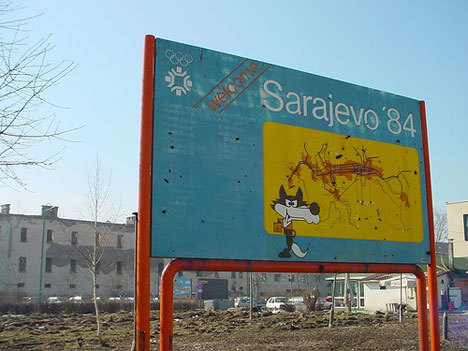
The 1984 Winter Olympics known as Sarajevo '84, was held between 8 and 19 February 1984 in Sarajevo, Yugoslavia.
Let's have a look of five impressive Forgotten Masterpieces in Sarajevo. Designed by Živorad Janković and Halid Muhasilović, Skenderija is a multi-functional cultural and sports centre completed in 1969. This building was the first of its kind in the former Yugoslavia and in many ways acted as a prototype for many similar complexes that were later built throughout the country. As such, Skenderija played a curial role in the development of not only the local architecture, but also of Yugoslavian modernist architecture as a whole. It was the first hybrid building in the former Yugoslavia that fused together many different functions (sports, performance, entertainment, shopping, food, service, etc.) within a singular multi-storey complex that employed a modernist aesthetics prevalent of the time.
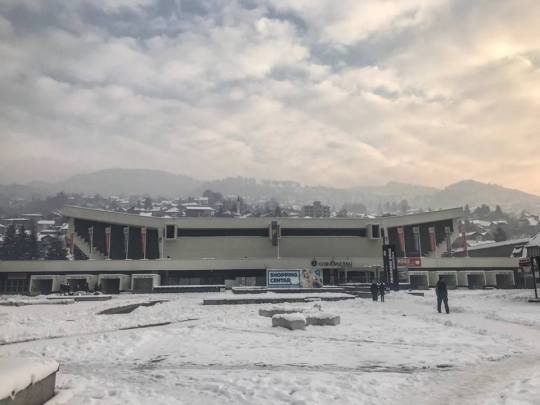
The complex consists of three buildings; a large sports hall in the first, a number of smaller sports halls in the second building and Dom Mladi (House of Youth) with cultural content in the third. | Photo Lejla Odobašić Novo
The buildings are arranged around an open plateau, a city agora, under which is located a subterranean commercial level with a circulation path that allows access all three buildings. The project was innovative in the complex construction system used that allowed for large spans. It also reflected the modernist ambition of honesty in the material use, with the concrete articulation of all the façades. In many ways, due to its scale and cultural significance, the complex shifted the symbolic gravitation from the old city centre and established an additional point of prominence. In urbanistic terms it expended the city beyond the exiting east-west axis and opened the south bank of the river Miljacka.


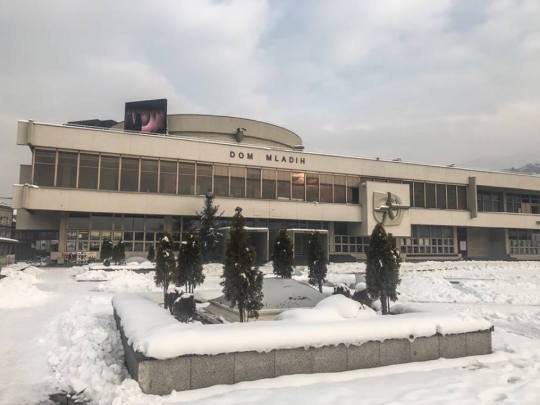
Skenderija allowed Sarajevo to take on a new cultural significance that would later be sealed by the Winter Olympics in 1984. | Photo Lejla Odobašić Novo
The Communist Party of Yugoslavia started the project of the Sarajevo’s main railway station as an architectural competition with the ultimate goal of physically uniting the country through its railway system. At the beginning of Socialist Yugoslavia, the country’s political views strongly aligned with those of the USSR and the remainder of the communist bloc. As such, Yugoslavian architecture at this time, although modernist in spirit was still heavily influenced by the social realism that was used as a political tool and prevailed in the majority of the eastern bloc countries.

The Railway station was opened in 1952 and in its thirty years of function, up until the siege in 1992, the building was one of the most monumental structures in Sarajevo. | Photo via Mirza Hasanefendic
Social realism in Sarajevo brought on a range of contradictions in its architectural articulation. It ranged from architecture for the masses most clearly articulated in the residential settlements for the worker’s housing to that of highly articulated and relatively well executed public buildings, mostly designed through architectural competitions.
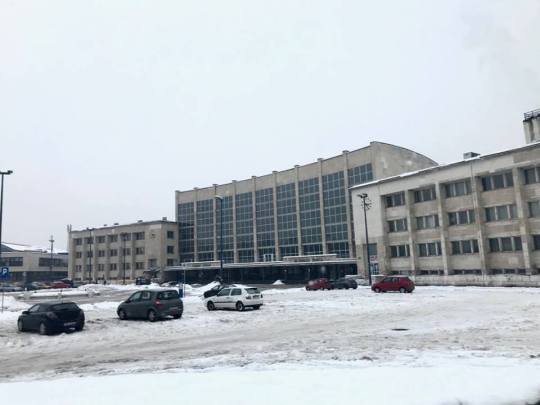
The main railway station in Sarajevo reflects the complexity of a more western modernism. | Photo Lejla Odobašić Novo
Once the initial reconstruction phase after WWII was completed cultural and institutional buildings became the next phase of focus. One of these included the Ministry of Public Health. It is heavily modernist in nature, however, the social realist influence remains visible. It was built only a few years after the main railway station but the break away from the social realism is even more apparent in this case. This shift in architectural expression occurred as a direct result in the political and ideological drift between Yugoslavia and USSR.
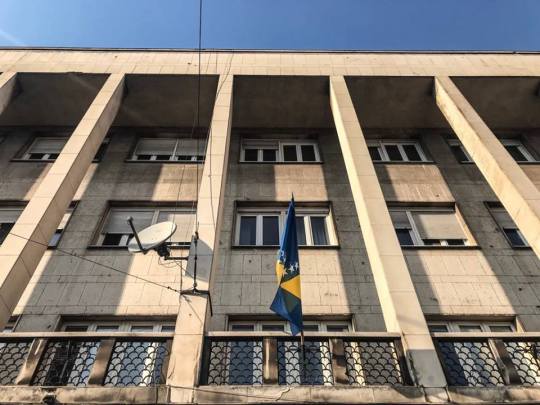
The building relies on pure geometry, abstracted decoration in the form of vertical fins at the front façade, simplified openings and a receded top floor which allow for a terrace on the top floor. | Photo Lejla Odobašić Novo
The principal focus of the social realism buildings was an exaggerated scale in order to instill the notion of grandness of the state and to inspire deference towards the authorities, which in this case was the Communist Party of Yugoslavia. Since this building was designed and built as a Ministry of Public Heath, Ivanović strived to employ majority of these principles but he broke away from some keys aspect that defied socialist realism at the time.
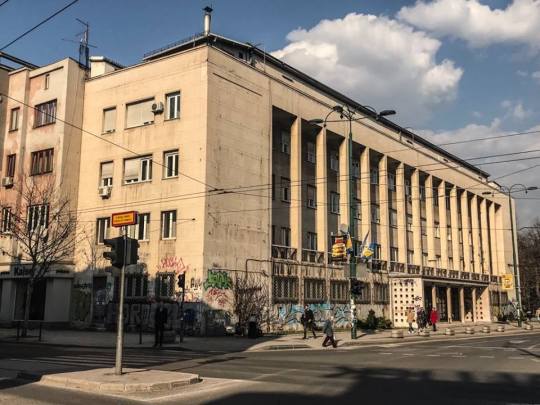
The building follows the rigid symmetry often employed by social realism and breaks a number of rules, which shift it towards a more ‘western’ modernist building. | Photo Lejla Odobašić Novo
The Communist party took control of Yugoslavia following the end of WWII in 1945. Like the majority of European cities, a considerable damage was suffered by the urban fabric in Yugoslavia as well. As such, one of the major tasks of the new socialist system was to rebuild as fast and as efficiently as possible. However, both the amount of resources and the number of available architects was limited and as such the initial wave of reconstruction was very utilitarian.
One of the most notable residential projects that dates back to the post-war period is the residential complex on Džidžikovac that resulted from a design competition set forth in 1947 and won by the above-mentioned Kadić brothers. The project was completed in just over a year which resulted in relatively poor construction quality, which was the case with many residential buildings constructed around this timeframe.
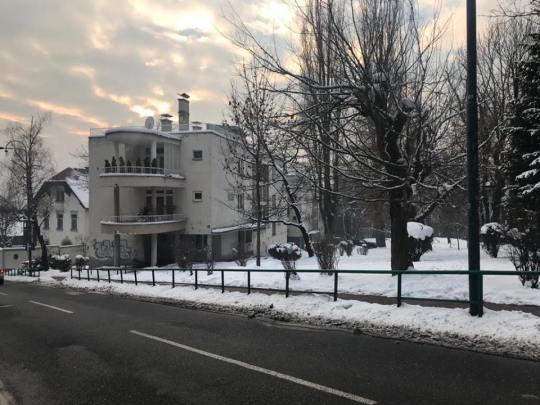
The design and the modernist spirit of the project render it as one of the most notable residential complexes in Sarajevo. | Photo Lejla Odobašić Novo
The complex contains three linear residential blocks each consisting of a number of three-storey interconnecting buildings that cascade along the existing topography. In addition, the three blocks are surrounded by open green space that integrates the building into the existing site forming a sense of a unified complex. Although the project has been declared as a protected national monument in 2008, the reconstruction done since the end of the siege in the 1995, has been to a large extent insensitive to the initial design principles of the Kadić brothers.
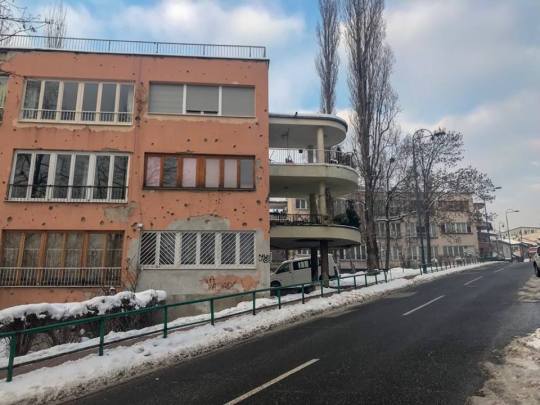
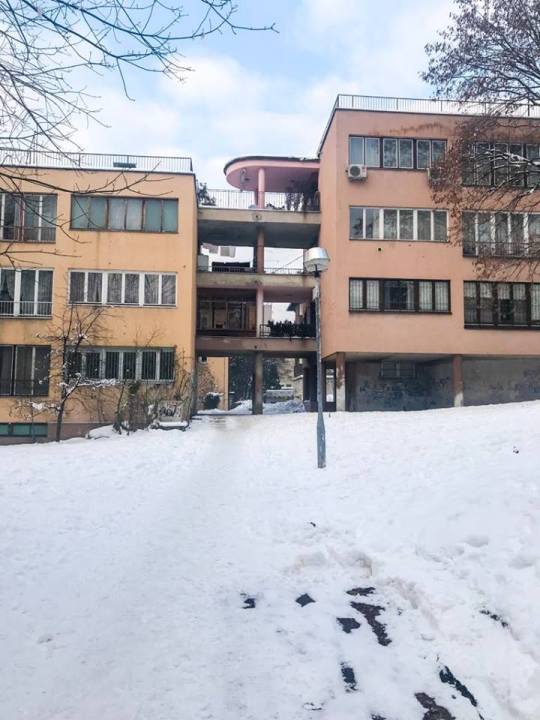
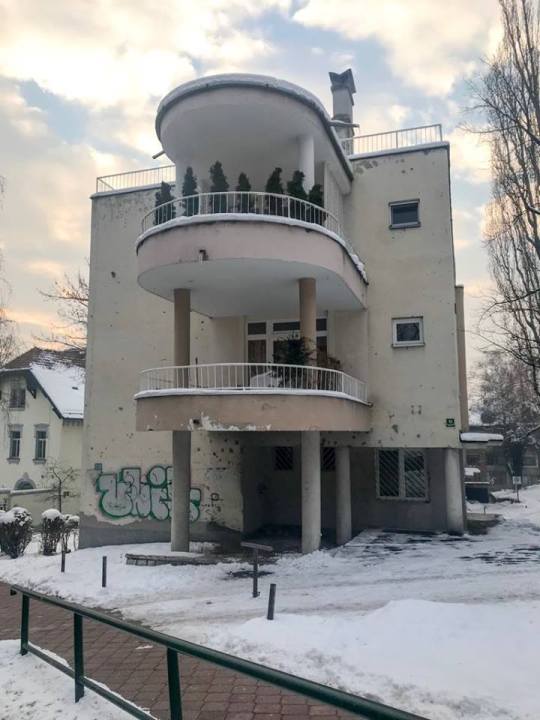
Each block have a set of semi-circular terraces suspended by receded columns - the signature feature of this project. | Photo Lejla Odobašić Novo
Completed in 1956, six years after the Ministry of Public Health, Residential Building and Šipad Headquarters breaks away from the social realist influence and draws inspiration from Oscar Niemeyer instead, thus creating one of the most prominent modernist buildings in Sarajevo.
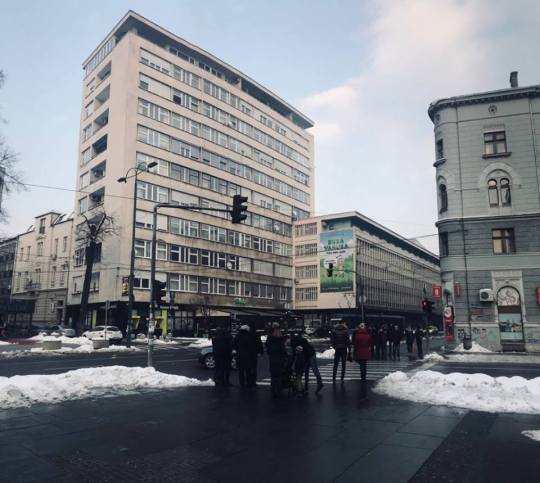
Although the two buildings are separate entities they lean on each other and share a part of the side wall. | Photo Lejla Odobašić Novo
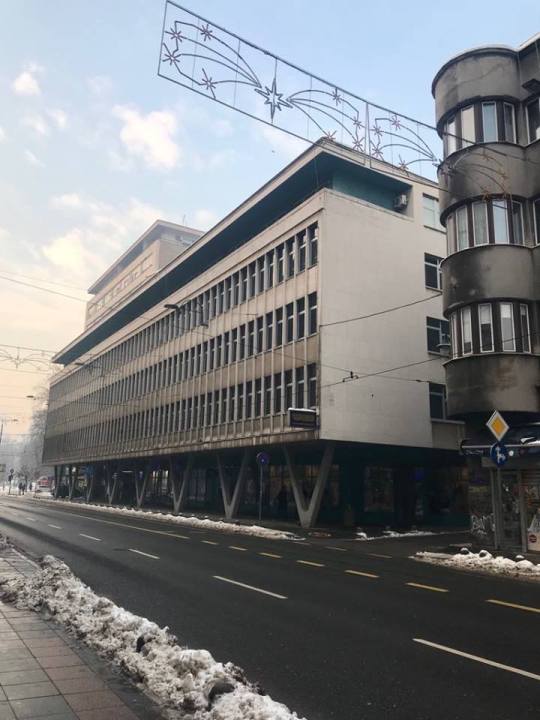

In order to allow for a continuous pedestrian flow, Ivanović frees part of the ground floor of the Šipad Headquarters, and thus creates a covered promenade lined with the distinct V shaped columns visually suspending the building off them. | Photo Lejla Odobašić Novo
---
#FOMA 44: Lejla Odobašić Novo

Photo by © Yasin Emir
Lejla Odobasic Novo is a Bosnian-Canadian architect and an architectural theorist who is currently working between Sarajevo and Toronto. She obtained her bachelor and master’s degrees from the University of Waterloo School of Architecture where she also held a research position and upon graduation worked as an Adjunct Professor at the Rome Campus. She holds a professional licence issued by the Ontario Association of Architects (2014) and is an Assistant Professor at the International Burch University in Sarajevo where she obtained her PhD and currently teaches architectural design and architectural theory. Lejla’s research focuses on the role of architecture, and in particular cultural heritage, in conflicted and contentious places. Within this field, she has carried out projects, exhibitions, publications and other cultural initiatives including her work with Liana Breser, Jerusalem-Sarajevo: In-between Cities, that was exhibited in Canada, UK, Bosnia and Croatia (2010-2011). She has also participated in DAAR Decolonizing Architecture residency and research group in the Palestine under Eyal Weizman, Sandi Hilal and Alessandro Petti (2010). Lejla is also a member of Kuma International, an International Center for the Visual Arts from Post-Conflict Societies. In addition to her academic work, she has also worked in architectural practices internationally including Toronto, London, Madrid, Rome and Istanbul.
49 notes
·
View notes
Text
mother daughter pandora charm 8auysvck91
The video started as an ad on the site. Then it was passed from friend to friend, often with comments and members recommending it. In the resulting discussions, the clip was cheap pandora charms played and commented on more than 9 million times by Facebook users and helped Nike double its number of Facebook fans from 1.6 million to 3.1 million over a single weekend. Ryan is a more resonant, a more mysterious character than this movie, for all its charms and intelligence, can safely handle. But his evasions and yearnings, set against the backdrop of recessionary rage, is nevertheless stronger stuff than just about anything else on the screens right now. Grade: A (Rated R for language and some sexual content.).
But to be honest with you, I get tired of all the rich and fattening food rather quickly and welcome a healthy fresh alternative. This is your year to shine with that healthy dish the next time you are pandora charms sale clearance uk asked to bring something to a holiday party. Here are a few ideas to get you started.. Levels and towns open up as you progress through the story, or by taking on one of the games many side quests. Once available you can then select any level from a world map Megaman style. You're free to explore each level as you see fit, kinda like Symphony of the Night or Metroid. I have been told that Arizona even has a bar dedicated to nothing but the Packers and the list goes on. Amazing tribute to a team that doesn't have their own cheerleaders (perhaps the only NFL team without cheerleaders) but it is no surprise to loyalist. Packer fans love the game and truly love their green and gold.
Weizman showed you can stay completely connected via phone, email, and fax even from the most remote desert island. The cheap pandora charms Internet cafe is a fixture in almost every country of the world. Cell phones are now ubiquitous. "An Evening with Rodgers and Hammerstein/The Sullivan Years" (TVT Records). This third in the series of selections from old Ed Sullivan broadcasts is probably the best so far. Taken from the early days of television, the sound quality is tinny and reminiscent of the trapped box sound of the radio era. The amusing Mr Clunes had an adolescence of concentrated embarrassments. He went around in huge flares that became suddenly redundant when punk came to London in 1976. Did he take to punk? "Yeah, I liked the outfits.
Beta is what you can get from a market index without any intervention by a manager. Skilled investors don't pay active management fees for market like returns, rather they buy overall market performance through index funds and exchange traded funds at the lowest possible price. For large institutions, that price is well under one tenth of 1 per cent, so these investors might pay $500 or less for every million dollars being managed.. The Republicans had they sound and well if I thought if I turned into play in yeah I had with this late date I'm lot of Republicans. Our are playing games and the Republicans really set the tone of the. Bottom line but it I don't care who had a playground and Sarah panel was up there as vice president Bentley was stoic as somebody does one thing doesn't he do that every act with the same in agreement here and I think I know but here enjoy.
1 note
·
View note
Text
A Saturday Evening Bauhaus Crash Course: What I Learned
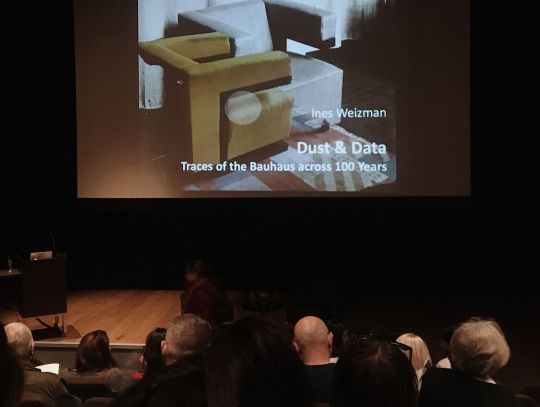
First of all, I’ll preface this post by saying that I’m not an academic, but simply a student with a basic understanding of the Bauhaus and a curiosity that landed me in the Nottingham Contemporary on a Saturday evening. If you want the real deal, be sure to check out Ines Weizman’s upcoming book “Dust & Data: Traces of the Bauhaus Across 100 Years”, after which this talk was named.
Housekeeping: check ✓ Now on to the good stuff.
Weizman - director of the Bauhaus Institute for the History and Theory of Architecture and Planning, and professor of architectural theory at the Bauhaus-Universität Weimar (phew!) - adopts an interesting approach to Bauhaus history. In essence, her work traces the geographical migration of “Bauhaus Modernism” post 1933, when the rise of Germany’s national socialist government forced the school to disband. As the words “dust” and “data” suggest, this fragmentation of a bold, avant-garde ideology created narrative black holes, and many important perspectives went unheard. It became clear to Weizman that mapping the trajectories of Bauhaus objects, documents and practitioners was the key to understanding their wider implications.
As someone with an increasing interest in the built environment, it was fascinating to learn more about the school’s aesthetic choices. For example, the Henry van de Velde building in Weimar was a hospital for the war wounded until Walter Gropius founded the school on the top floor in 1919. Rather than starting from scratch, Bauhaus architects worked with the space, offsetting curved staircases with distinctly modernist geometry. Meanwhile, the only purely Bauhaus structure to emerge in Weimar, the Haus am Horn (House and Home), was a celebration of hygiene, boasting metal furniture and surfaces that could be dusted to perfection and seemed never to age. When the school eventually moved to Dessau, the masters’ villas embodied a simplicity that felt at once functional and luxurious.

House am Horn interior
But the Bauhaus’ desire to make a scientific approach to art and architecture accessible was at odds with the national socialist rhetoric of the 1930s.
Through extensive research into the materiality of Bauhaus objects, Weizman has tracked the subsequent migration of German-Jewish practitioners across countries. It was interesting to learn that, through microscopic analysis of building materials, Bauhaus architecture could be traced through the Middle East, with Palestine importing cement from Germany in the 1930s, and many tiles, pipes and doorhandles being of German manufacture. Woven carpets have even been created to document the colour history of a building in Tel Aviv, a city known for its white modernist buildings. With the ripples of the Bauhaus emanating ever further, it became crucial for these material traces to be gathered, preserved, and organised coherently. “Dust & Data” - the digital collection of the physical.
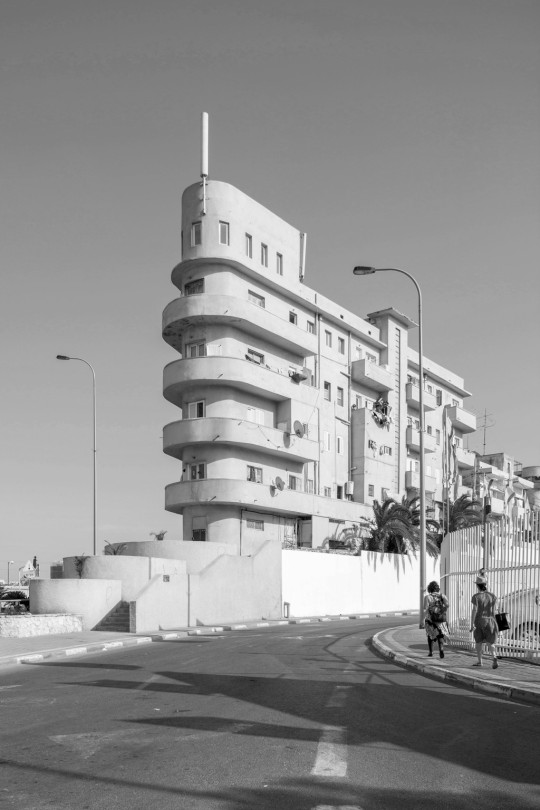
Bauhaus architecture in Tel Aviv © galit seligmann / Alamy Stock Photo
Overall, I came away from the talk with a clearer understanding of the chronology and geography of the Bauhaus, but also a greater appreciation for the use of scientific processes within design research. Weizman adopts the analytical eye of a private investigator, following a trail of breadcrumbs from country to country in search of a deeper creative understanding. For my own upcoming projects, adopting the role of investigator will be key, and after today’s talk I feel empowered to look beyond the obvious and find what lies beneath.
2 notes
·
View notes
Quote
Indeed, the reading lists of contemporary military institutions include works from around 1968 (with a special emphasis on the writings of Deleuze, Guattari and Debord), as well as more contemporary writings on urbanism, psychology, cybernetics and postcolonial and poststructuralist theory. If writers claiming that the space for criticality has to some extent withered away in late twentieth-century capitalist culture are right, it surely seems to have found a place to flourish in the military.
Eyal Weizman, “Lethal Theory” (pdf here)
4 notes
·
View notes
Text
13.04. READINGS WEEK 12.
PAOLO CIRIO’S ESSAY “EVIDENTIARY REALISM” AND FULLER, WEIZMAN’S INTRODUCTION FROM “INVESTIGATIVE AESTHETICS” CONVEY COMPELLING VIEWS ON THE RULE OF CONTEMPORARY ART IN THE XXI CENTURY.
THE CLAIM PROPOSED IN THE SOURCES IS THAT TO BE PROPER MILITANT ARTISTS TODAY, THERE SHOULD BE A FOCUS ON THE INDEPENDENT INVESTIGATION OF REALITY.
THE CASE OF FORENSIC ARCHITECTURE EXEMPLIFIES THIS: A GROUP OF RESEARCHERS FROM DIFFERENT BACKGROUNDS COLLABORATES ON THE ANALYSIS OF VARIOUS FOOTAGE FROM VARIOUS WAR SCENARIOS TO DECONSTRUCT THEM AND PRESENT THEM FACTUALLY VIA 3D RECONSTRUCTIONS.
FORENSIC ARCHITECTURE CONTAINS ALL THE COMPONENTS WHICH RENDER CONTEMPORARY ART APPEALING: THE COLLABORATION OF PEOPLE FROM DIFFERENT STUDIES, THE USE OF DIFFERENT VISUAL MEANS AND THE APPLICATION OF CONTEMPORARY TECHNOLOGY FOR CONCRETE CIRCUMSTANCES.
WHAT IS APPARENT FROM THE READINGS OF CIRIO AND WEIZMAN IS THAT ART NEEDS TO SPEAK ABOUT THE TIME IN WHICH IT IS CREATED AND CONSUMED.
THIS ALLEGATION MAY SOUND NATURAL TO YOUNG REVOLUTIONARY SPIRITS. HOWEVER, WHEN WE COME INTO CONTACT WITH THE MAINSTREAM ART SCENE OF A CITY LIKE ROME, OPEN-AIR MUSEUM AND HOMELAND OF THE 60S ITALIAN AVANT-GARDE, WE REALIZE ART IS PERCEIVED AS SOMETHING ELSE.
WHEN ANALYZING THE ROMANIAN CURRENT ART EXHIBITIONS SCENE FROM THE POINT OF VIEW OF AN EX-STUDENT OF A COLLECTION BUILDING AND MUSEUM STUDIES COURSE, ONE CANNOT HELP TO REMEMBER INSTRUCTOR SARAH LINFORD’S WORDS ON THE “BLOCKBUSTERS” EXHIBITIONS, MEANING TEMPORARY EXPENSIVE SHOWS THAT NONETHELESS CAPTURE THE ATTENTION OF A VAST PUBLIC.
EXHIBITIONS LIKE THE €15 CHIOSTRO DEL BRAMANTE’S “MICHELANGELO PISTOLETTO: INFINITY”, THE €13 MAXXI’S “BOB DYLAN RETROSPECTRUM”, OR THE €10 MOST CENTRALLY LOCATED PALAZZO CIPOLLA’S “RAOUL DUFY: THE PAINTER OF JOY” ACT, EITHER FOR THE ARTWORKS SHOWN OR FOR THEIR CURATION, MORE AS 19TH-CENTURY PEEPSHOWS THAN AS THE SAME-CENTURY EARLY PHOTOGRAPHS.

PROOF OF CHIOSTRO DEL BRAMANTE'S ENTRY FEE. OTHER FEES FOR THE ABOVE CITED EXHIBITIONS CAN BE FOUND HERE -SECTION "VISITA IL MAXXI AND HERE
IN AMY F.OGATA “VIEWING SOUVENIRS, PEEPSHOWS AND THE INTERNATIONAL EXPOSITIONS”, OGATA DESCRIBES 19TH-CENTURY PEEPSHOW SOUVENIRS FROM THE FIRSTS WORLD’S FAIRS AS EXAMPLES OF WHAT WALTER BENJAMIN DESCRIBED AS THE “PHANTASMAGORIA” RELATED TO THE EARLY STAGES OF MASS CONSUMPTION.
BY SHOWING EXHIBITIONS THAT PASSIVELY ENCHANT THE VIEWER INTO A “PHANTASMAGORIA” WORLD MADE OF RECOGNIZABLE ARTISTS, IDENTIFIABLE ART MOVEMENTS AND INTERACTIVE INSTAGRAMMABLE CORNERS, THE ROMANIAN ART SCENE RENDERS ART A MASS CONSUMPTION PRODUCT.
NONETHELESS, WE ARE LED TO COMPREHEND SUCH DECISIONS IF WE COMPARE THE ANNUAL BUDGET OF THE ITALIAN MINISTRY OF BENI CULTURALI (1.6 BILLION EUROS, 2019) WITH THE ONE OF THE FRENCH MINISTRY OF CULTURE (3.8 BILLION EUROS, 2021).
FRANCE IS, NONETHELESS, THE SAME COUNTRY WITH REGIONAL FUNDS FOR CONTEMPORARY ARTISTS.
HOW MUCH VALUE CARRIES A STATE-FUNDED ARTIST IN COMPARISON TO AN INDEPENDENT ONE?
AMONG THE FUNDING ORGANIZATIONS FOR FORENSIC ARCHITECTURE, ONE FINDS:
THE EUROPEAN RESEARCH COUNCIL;
OPEN SOCIETY FOUNDATIONS ($18 BILLIONS)
OAK FOUNDATION (£481 MILLIONS);
SIGRID RAUSING TRUST (£429 MILLIONS);
TO BE FOUNDED BY PROMINENT ORGANIZATIONS OBVIOUSLY DOES NOT REDUCE THE VALUE OF AN INSTITUTION.
HOWEVER, IT POSES A DOUBT OVER THE CONCRETE CHANCE OF INDEPENDENT ARTISTS TO REALIZE A PROJECT LIKE FORENSIC ARCHITECTURE.
THERE COMES THE QUESTION POSED BY FULLER AND WEIZMAN TOO, WHETHER IS THIS ART OR INVESTIGATION.
TO THIS STANCE, ONE MAY FIND HESITATIONS IN THE OUTCOMES OF PAOLO CIRIO’S PROFESSED EVIDENTIARY REALISM.
CIRIO AND WEIZMAN RELY ON DIGITAL TOOLS TO CONSTRUCT A FACTUAL DEMONSTRATION OF REALITY, WHICH OPPOSES THE XXI CENTURY NOVICE REGIMES’ MANIPULATION OF THE TRUTH MADE POSSIBLE BY ACCESS TO TECHNOLOGICAL DEVICES.
THE DOUBT LIES IN WHETHER, BY IMPOSING A PRACTICAL TRUTH ON ITS PRODUCTS, AS PAOLO CIRIO’S INTRODUCTORY PARAGRAPHS FROM BRECHT’S WRITING THE TRUTH DEMANDS, EVIDENTIARY REALISM IS ACTING AGAINST ART’S DEMAND OF POSING DOUBTS IN THE VIEWERS.
IF WE NEED TO RELY ON TECHNOLOGY TO DEMONSTRATE A FACT, ARE NOT WE CLAIMING THAT HUMAN COGNITIVE CAPACITIES CAN BE EXCHANGED WITH AI?
IN RESPONSE TO PAOLO CIRIO’S CLAIMS, ONE COULD POINT OUT THE CASE OF PIERPAOLO PASOLINI’S LAST MOVIE SALÒ.

PASOLINI' SALÒ POSTER
BY SHOWING THE “PHANTASMAGORICAL” ATTITUDES OF A GROUP OF FASCISTS TOWARDS EVERY FORM OF VIOLENCE, PASOLINI COMMUNICATES EXACTLY THE OPPOSITE OF WHAT HE IS SHOWING.
ULTIMATELY, A COUNTER-RESPONSE TO PAOLO CIRIO AND WEIZMAN’S DEMAND OF CONTEMPORARY ART TURNING TO REALISM COULD BE THAT ART CAN BE ABOUT THE REAL, WITHOUT BEING REAL.
IN THESE TERMS, A LAST REFLECTION BY TOMASO MONTANARI ON WHAT IS ART TODAY PROPOSES AN ANSWER BY USING THE EXAMPLE OF GIOVANNI DE GARA’S INTERVENTION ON THE BASILICA OF SAN MINIATO, IN FLORENCE.
youtube
ART HISTORIAN TOMASO MONTANARI LESSON
IN 2018, THE ARTIST TREATED THE ROMANICHAL BASILICA’S FAÇADE WITH GOLD THERMAL BLANKETS, COMMONLY USED WHEN RESCUING MIGRANTS.

GIOVANNI DE GARA - ELDORATO - JUNE 2018 - BASILICA OF SAN MINIATO - FLORENCE
BY COMMENTING ON THE THEME OF HOSPITALITY PERSONIFIED IN THE DOOR ELEMENT, AND MAKING A STATEMENT ON THE ROLE OF CHRISTIAN’S MANTRA OF “LOVE THY NEIGHBOR AS THYSELF”, THIS INSTALLATION PROVES HOW ART CAN TALK ABOUT THE REAL WITHOUT BEING RELATED TO DATA AND TECHNOLOGY.
0 notes
Text
past list.thought.graphies found found in an old notebook
1/22/2025
architecture and the built environment is a kind of slow violence — eyal weizman
1/23/2015
inside of our lives
1/25/2015
“we often arrive at the idea that the system is ‘broken’ not because we have such a strong attachment to the state, but because we have a scarcity of language around the intensity of its violence.”
“inhabiting a set of shifting contradictions.”
eric a. stanely
2/3/2015
more than 200 million tons of bombs were dropped on laos by american planes attacking communist troops
average of one bombing sortie every eight minutes for nine years
plain of jars vegetation had been stripped by american defoliants
napalm fires burned day and night
2/6/2015
terrorism is an existential threat not so much for what terrorists do, but for how liberal societies respond. — shadi hamid
electricity of the spine
the vertigo that sometimes accompanies the simple act of waking up
sudden fear of resurrection
charred remains of a world
2/18/2015
no one sees the compromised ground underneath
i am, indeed, an exception to the rule, but not the rule you think.
secrets that unforgivable but people are forgiven
2/23/20215
what will survive of us is love — philip larkin
compromise of justice
bodies moving through the same life differently — claudia rankine
the state of emergency is also always a state of emergence — claudia rankine
i don’t know how to end what doesn’t have an ending.
3/3/2015
lack of diversity is a symptom. the underlying illness is institutional racism. — daniel jose older
3/5/2015
the soft percussion of lips against skip. — jon mcgreggor
3/10/2015
we couldn’t bear to look, and all we did was look. — anthony lane
thousands died on september 11, and they died for real; but thousands died together, and therefore something lived. — anthony lane
i felt almost as if i had come to a planet where the gravity was a little different
the asymmetries of the world
6/19/2015
“are you alright?” — sometimes
0 notes
Quote
Nonetheless, the use of criminal evidence as eye-catching exhibits for the entertainment of gallery-going art consumers is questionable, and becomes more troubling as Forensic Architecture gain prominence in the art world.
Eyal Weizman, founder of Forensic Architecture in a talk at the Institute of Contemporary Art (ICA)
0 notes
Text
Hear how three startups are approaching quantum computing differently at TC Disrupt 2020
Quantum computing is at an interesting point. It’s at the cusp of being mature enough to solve real problems. But like in the early days of personal computers, there are lots of different companies trying different approaches to solving the fundamental physics problems that underly the technology, all while another set of startups is looking ahead and thinking about how to integrate these machines with classical computers — and how to write software for them. At Disrupt 2020 on September 14-18, we will have a panel with D-Wave CEO Alan Baratz, Quantum Machines co-founder and CEO Itamar Sivan and IonQ president and CEO Peter Chapman. The leaders of these three companies are all approaching quantum computing from different angles, yet all with the same goal of making this novel technology mainstream.
D-Wave may just be the best-known quantum computing company thanks to an early start and smart marketing in its early days. Alan Baratz took over as CEO earlier this year after a few years as chief product officer and executive VP of R&D at the company. Under Baratz, D-Wave has continued to build out its technology — and especially its D-Wave quantum cloud service. Leap 2, the latest version of its efforts, launched earlier this year. D-Wave’s technology is also very different from that of many other efforts thanks to its focus on quantum annealing. That drew a lot of skepticism in its early days but it’s now a proven technology and the company is now advancing both its hardware and software platform.
Like Baratz, IonQ’s Peter Chapman isn’t a founder either. Instead, he was the engineering director for Amazon Prime before joining IonQ in 2019. Under his leadership, the company raised a $55 million funding round in late 2019, which the company extended by another $7 million last month. He is also continuing IonQ’s bet on its trapped ion technology, which makes it relatively easy to create qubits and which, the company argues, allows it to focus its efforts on controlling them. This approach also has the advantage that IonQ’s machines are able to run at room temperature, while many of its competitors have to cool their machines to as close to zero Kelvin as possible, which is an engineering challenge in itself, especially as these companies aim to miniaturized their quantum processors.
Quantum Machines plays in a slightly different part of the ecosystem from D-Wave and IonQ. The company, which recently raised $17.5 million in a Series A round, is building a quantum orchestration platform that combines novel custom hardware for controlling quantum processors — because once quantum machines reach a bit more maturity, a standard PC won’t be fast enough to control them — with a matching software platform and its own QUA language for programming quantum algorithms. Quantum Machines is Itamar Sivan’s first startup, which he launched with his co-founders after getting his Ph.D. in condensed matter and material physics at the Weizman Institute of Science.
Come to Disrupt 2020 and hear from these companies and others on September 14-18. Get a front-row seat with your Digital Pro Pass for just $245 or with a Digital Startup Alley Exhibitor Package for $445. Prices are increasing next week, so grab yours today to save up to $300.
( function() { var func = function() { var iframe = document.getElementById('wpcom-iframe-bc5e644f85a11b970469253c6a947a65') if ( iframe ) { iframe.onload = function() { iframe.contentWindow.postMessage( { 'msg_type': 'poll_size', 'frame_id': 'wpcom-iframe-bc5e644f85a11b970469253c6a947a65' }, "https:\/\/tcprotectedembed.com" ); } } // Autosize iframe var funcSizeResponse = function( e ) { var origin = document.createElement( 'a' ); origin.href = e.origin; // Verify message origin if ( 'tcprotectedembed.com' !== origin.host ) return; // Verify message is in a format we expect if ( 'object' !== typeof e.data || undefined === e.data.msg_type ) return; switch ( e.data.msg_type ) { case 'poll_size:response': var iframe = document.getElementById( e.data._request.frame_id ); if ( iframe && '' === iframe.width ) iframe.width = '100%'; if ( iframe && '' === iframe.height ) iframe.height = parseInt( e.data.height ); return; default: return; } } if ( 'function' === typeof window.addEventListener ) { window.addEventListener( 'message', funcSizeResponse, false ); } else if ( 'function' === typeof window.attachEvent ) { window.attachEvent( 'onmessage', funcSizeResponse ); } } if (document.readyState === 'complete') { func.apply(); /* compat for infinite scroll */ } else if ( document.addEventListener ) { document.addEventListener( 'DOMContentLoaded', func, false ); } else if ( document.attachEvent ) { document.attachEvent( 'onreadystatechange', func ); } } )();
0 notes
Text
PHOTOGRAPHY AND THE CONSTRUCTION OF THE POST-TRUTH ENVIRONMENT.
“Truth may be stranger than fiction, but many of the camera’s statements are stranger than truth itself… after countless processes of reproduction and re-reproduction [the photograph] has become an autonomous entity on its own [and] functions almost as a symbol, an image, a work of art in its own right”
Extract from Reyner Banham’s essay ‘Parallel of Life and Art’, Architectural Review (1953)
If one rhetoric has been exhausted above all others during the past twelve months, it is that we now live in a post-truth world. Despite unanimous agreement that this no sort of accomplishment, given their sudden emergence and subsequent pervasiveness in mainstream media, post-truth narratives have often tailed into sensationalism; implying the immediate abandonment of all transparency and certainty, within the duration of a ballot count.
Nonetheless, for many artists, probing the nature of truth in society is nothing new. From Reyner Banham’s seminal review of Parallel of Life of Art (1953) [i], via John Berger’s Ways of Seeing (1972) [ii], and as recently as Wolfgang Tillmans’ Truth Study Centre (2005) [iii], critical investigations have long emphasized visual media’s role in the construction of preconceived principles and judgments.
At a time when a resurging appreciation of brutalist aesthetics has triggered enquires into the writing and rewriting of the movement’s history, it is no coincidence that the presence of Banham’s critical spirit could be felt across multiple major exhibitions of the first post-truth summer. Engaging particularly with the relationship between visual reproduction and symbolism, Wolfgang Tillmans’ solo exhibition at the Tate Modern, David Campany’s A Handful of Dust at the Whitechapel Gallery, and Akram Zaatari’s Against Photography: An Annotated History of the Arab Image Foundation at the MACBA, all reassess the dualism of art and reality to reveal how the photograph - more than a mere documentation of the latter - can function as a work of art in its own right. Coincidentally, with the infamous Brexit Bus having since become an unlikely metaphor for a referendum of unfounded claims and inevitable compromise, the exhibitions pay particular attention to the photographic production and reproduction of vehicles. This is a part of a wider common focus on material objects and the relationships implicated by their visual representation. As suggested by Eyal Weizman’s Forensic Architecture, these connections are made problematic when images, whether they are cultural symbols or judicial artifacts, become politicized; a process for which the artist’s accountability must also be evaluated.
Having dual German and British citizenship, Wolfgang Tillmans’ engagement with the EU referendum reflected at once his personal anchoring to the matter and a consciousness towards the political responsibilities of the artist. Nonetheless, whilst the posters and prints he designed for the Remain movement feature in his latest solo exhibition, Tillmans’ interest in the political rhetoric now associated with Brexit’s chaotic upheaval - of unfounded claims and inevitable compromise - predates the recent referendum. Coming to prevalence at the start of the 21st century, the artist’s emergence coincided with the politics of the “Unknown-unknown”; a phrase coined in 2002 by Secretary of Defense Donald Rumsfeld to describe the supposed threat of nuclear arms in the Middle East and justify the USA’s subsequent invasion of Iraq in 2002. Such oblivious ignorance towards the political prerequisite of certainty, and the increasingly ever-warping standards of truth and justice, would influence Tillmans’ 2005 book and exhibition Truth Study Centre. Further inspired by the blanket denial of HIV and AIDS by certain orthodox organizations in Africa, Tillmans is conscious of the way that media, in cohesion with other political institutions, seeks to deliver truth, and the socio-political implications of making such a claim. To exhibit the photographic work of Truth Study Centre, Tillmans interweaved his intensely-personal images with various photocopied newsprints and press-clippings reacting to specific events. Across the thirteen tables Tillmans presents, severe disjuncture emerges. The result is a set of conflicting, incongruous narratives, all claiming to represent the truth, whilst in reality undermining photography’s credibility as a documentary tool, disrupting the pretense of journalistic objectivity, and suggesting the possibility of interplay between the two.
With the Tate exhibition also encompassing his previous works Fruit Logistica (2012) [iv] and The Cars (2015) [v], the audience is urged to reassess its understanding of material objects and recognize how images can multiply and manipulate their meaning. Whilst material goods are so often understood – if at all - as fixed sign of everyday life, the exhibition stresses the myriad of social and cultural interactions that define the relationship between commercial photography and materiality, both in terms of the advertising of capitalist goods, and the physical reproduction of images. With the development of high-resolution printing and scanning devices enabling his growth as an artist in the past two decades, Tillmans has long utilized his natural attunement to visual reproductive technologies to explore their capacity to manipulate reality. Aligning photographs taken at a fruit exposition in Berlin with parallel images from a screen-printing fair in Barcelona, Fruit Logistica blurs the boundary between the actual and the technologically reproduced; satisfying Banham’s assertion, and materializing the image of the organic object into an autonomous entity. Beyond an ode to his own medium, the 2012 work served as a wary assessment of the capabilities of commercially reproduced imagery as a recreator and proliferator of modern, street-level assumptions.
This is further explored in The Cars, which unravels the excess materialities of the automobile. Intrigued by the photographer’s tendency to edit or remove any signs of vehicles from architectural images as if they are obstructions, Tillmans presents the vehicle as an inescapable and productive feature of the urban landscape. Aligning photographs of passing cars, as would be immediately perceived by the artist, with both static and commercially-derived images, the work reveals the vehicle’s multifaceted social and cultural identities. Whilst the first form of images present the car as an object of physical urban movement – the moving subjects often blurred, unidentifiable or in an anonymous mass – more precise assessments of car design reveal an underside of calculated inequalities. The presentation of luxury cars as polished objects of desire not only conflicts with the experience of vehicles for the vast majority of the world’s population, but reinforces the car as a vehicle of not only physical, but also social and economic mobility. Right down to Tillmans’ (perhaps tongue-in-cheek) observation of the increasingly menacing appearance of headlights, Cars is an intriguing insight into the grander hegemonic forces for which the automobile is a symbolistic vehicle.
By defetishizing the car, Wolfgang Tillmans engages with what the philosopher Slavoj Zizek describes as the “unknown-knowns” of society; the disavowed beliefs, suppositions and obscene practices we pretend to not know about even though they form the background of our public values [vi]. Whilst Donald Rumsfeld justified the Iraqi invasion as self-defense against a speculative and generalized threat, Zizek’s interpretation - reacting to the Abu Ghraib scandal, and the obscenely-celebratory images through which it was delivered to the Western world – reframes this fear as an internalized and constructed specter of the Islamic world. Seeking a link between cultural assumptions and the means via which Orientalist narratives are produced, Akram Zaatari’s Against Photography: An Annotated History of the Arab Image Foundation [vii] uses images of the vehicle in twentieth century Egypt to simultaneously trace the lineages of the country’s modernization, and underline the problematic nature of documentary archives. Stemming from his work with the Arab Image Foundation, a photographic collection and preservation archive which currently holds a record of over 30,000 images from the Middle East and North Africa, Zaatari’s project faces both the internal challenge of a culture in which photography is not as openly embraced, and the external difficulties presented by the selectiveness of Orientalist representations of Arabic world. Images which appear to symbolise modernisation, like that of an Egyptian man posing next to a Western automobile, are concealers of hidden privileges such as having the status and wealth to sit for a photographer in the early twentieth century. In the meantime, lending to the increasing popularity of the automobile, Syrian nomadic culture disappears without photographic trace. Such inequalities of privilege and preference manifest themselves in Zaatari’s wealth of Egyptian tourist photos; many of which have been deliberately underexposed to ensure that local workers are obscured to nothing more than barely visible shadows, whilst simultaneously emphasizing the pale skin of the Western travelers posing camel-back. Having remapped the landscape in line with notions of territorial identity, themselves a by-product of the borders fixed by European colonial powers at the beginning of the twentieth century, Zaatari argues that the automated vehicle has replicated geographical colonialist legacies. Thus, with the camel repressed as a nomadic tradition, yet all too prevalent in these type of images, its reproduction in Orientalist contexts marks the divergence between the reality of Arabic modernization and its photographic representation.
It is now evident that attempting to construct a historic order or lineage using only photographic sources can have severe limitations and implications. Nonetheless, having seen its capacity to reveal modern intimations, both intentionally and accidentally, it is equally problematic to denounce photography as a documentary medium. As Reyner Banham asserted, across the lifetime of a photograph – caught in the balance between instantaneousness and timelessness – its meaning can be radically altered and exploited. Therefore, any artist willing to embrace photography as a documentary tool must possess a heightened awareness of such timings, particularly in a political context.
To navigate this issue, curators whose work comprises of building histories via the photographic medium must acknowledge that their work is merely speculative, particularly if they assume a privileged position.
One artist to do this is David Campany, who embraces the flexibility of the photograph in his book A Handful of Dust (2015) [viii], subsequently presented at the Whitechapel Gallery. An imaginative and experimental realignment of culture and photography in the twentieth century, Campany probes the multiple facets of an image made by Man Ray and Duchamp in 1922, now commonly referred to as Dust Breeding, to hypothesize the development of the medium’s chemical, artistic and documental nature. Campany’s work underlines the ease with which a determined narrative can be curated through images, but simultaneously reiterates the danger this carries. Despite being wholly apolitical, A Handful of Dust’s narrative is neither accidental or coincidental, and rather the work of an artist whose curation process involves highly-privileged access to archival and documental sources. Therefore, whilst they occupy different spheres, A Handful of Dust shares many of the privileges exercised by the very powers that Akram Zaatari attempts to subvert.
Thus, if the image is made problematic by a process of reproduction which emphasizes one narrative over the other, then how does a medium so vulnerable to misinterpretation, yet with so many inextricable ties to truth, continue its documental responsibilities into the future?
Advancing on the notions of Gerry Badger’s CCCB exhibition Propaganda Books Versus Protest Books [ix], which tests the flexibility of photographic interpretation in the most intense political situations, Eyal Weizman’s MACBA installation Forensic Architecture: Towards an Investigative Aesthetics [x] works against the manipulating nature of war images to propose an alternative process of investigative photography. As outlined in the project’s de-facto manifesto, Forensic Architecture: Violence at the Threshold of Detectability (2017) [xi], Weisman’s demand for more material and aesthetic engagement with the implications of state violence and armed conflict marks an evolution of the constructionist work of his contemporaries. Bringing such ideals into the legal realm, the Goldsmith’s-based research firm provides a blueprint for the future of photographic documentation which acknowledges the medium’s role in constructing inequalities, only to stress its parallel capacity to rework them. When the presence of an image is multiplicitous - its manipulations at any one time political, juridical, institutional and informal - any attempt to counter-act such processes must be likewise. Therefore, rather than abandon photography as a documentary medium, and in turn surrendering its power, Weizman engages with the functions and vulnerabilities of the image, to re-formulate it is a forensic medium.
The decision to initiate Forensic Architecture, claims Weizman, was inspired by the ground-breaking investigative work of Richard Helmer. With a team of fellow pathologists, Helmer orchestrated the positive identification of Josef Mengele in Sao Paolo, Brazil, following the exhumation of the body of the Nazi war criminal in 1979. Unlike traditional forensic analyses, the Mengele identification process collated and combined, for the first time in an instance of such importance, various forms of photographic imagery to develop a bank of visual evidence sufficient to provide a conclusive identification. With photographic stills of Mengele being the only available source from which to identify a likeliness between the subject and the exhumated skeleton, Helmer moved beyond the superficial capacity of the photograph by imposing static images of the criminal’s head over video images of the found skull. When the result was deemed sufficient evidence to positively identify Mengele, Helmer had initiated a new wave of technological forensics.
Taking issue with the tendency of traditional forms of conflict documentation to drive parochial narratives, Forensic Architecture builds upon Helmer’s legacy in its demand for innovative sources of visual evidence used in response to issues as wide as terrorism, state-violence, and climate change. The need to drive for innovation, however, is also a politically enforced one. Investigations carried out by Forensic Architecture into civilian deaths and drone strikes in North Warizastan have faced obstacles in the form of the state’s control of satellite imagery. Unmanned aerial vehicles have re-configured the geographies of conflict, making anybody visible – thus, vulnerable – at any moment, no matter their location. Simultaneously, this form of panoptic surveillance has birthed a new wave of image conflict. It is perhaps no coincidence that when UAVs surface on the news, it is too often to report cases of friendly-fire or the destruction of unintended targets; over drone footage of scrolling, dark foothills, and human settlements reduced to silhouettes of white-heat. When drone strikes can leave an entrance hole as small as 4cm in the roof of a building, for the Forensic Architecture team, tracing the genealogies of an attack can be an incredibly difficult task. To make secondary visual evidence more inaccessible, censorship of US military satellite imagery renders any suspected victims virtually invisible, with the resolution of images degraded, supposedly on the grounds of privacy and security, to the extent that a male body is masked within the square of a single pixel. As a result, when investigating civilian deaths, Weizman and his team are forced to undergo a process of visual reconstruction, using a combination of primary visual accounts of the drone strikes, and sources of secondary information which hasn’t been rendered unusable by state control. Investigating a case in Miranshah, Northern Warizastan, video footage of the site’s wreckage, which had been smuggled out of the zone and aired on public TV, was meticulously studied to build a spatial visualisation of the attack. Using a collage technique from single frames, Weizman and his team were able to reconstruct the building, reveal the scale of damage, and estimate casualty numbers. Once a location has been identified, this can then be verified by publicly available resources, even those as rudimentary as Google Maps, and subsequently tied back to known drone attacks.
Another area that Forensic Architecture has been active is in Palestine, where it has sought to hold IDF forces accountable for crimes when existing evidence falls short. In the case of Bassem Abu Rahma, who was struck and subsequently killed by a tear-gas canister during protests in Bil’in, West Bank in 2009, Weizman and his team of investigators used available primary evidence to create a comprehensive audio-visual spatial analysis of the event, and subsequently challenge the Israeli verdict of accidental death. For Palestinians, the camera is an essential protest tool. Beyond its empowering potential for publicity, it is also too often the only piece of evidence capable of proving excessive-force and out-right violence against demonstrators.
Further considering the IDF’s notoriety for targeting and destroying Palestinian cameras, video-recorders are therefore indispensable for protestors, and Weizman was fortunate enough to access an abundance of visual footage at the scene of Abu Rahma’s death. Identifying the firing of the munition by a soundbite to begin with, the forensic architects synced the footage of three on-site recordings, and subsequently used satellite imagery to trace the movement of the corresponding cameramen on a map. This enabled Weizman to locate the victim, the trajectory of the munition, and a wired-fence, which according to Israeli military caused a ricochet that forced the direction of the canister towards Abu Rahma. It was a single still-frame of David Reeb’s footage, fatally marked at 5:44:07, which pinpointed the final contact, and where all possible trajectories were analysed. Weizman devised a threshold to determine whether the shot was fired directly at Abu Rahma, or if a supposed ricochet was plausible. Calculating a maximum angle at which the shot could have realistically caught the wire fence by chance, and thus be deemed an accident, the investigation concluded that the canister had been deliberately aimed towards the victim. Weizman’s evidence caught the attention of various human rights organizations and in July 2010, the Israeli military backtracked on their previous statements by re-opening a criminal investigation into the case. After an initial failure to prosecute the soldier guilty of killing Abu Rahma, the victim’s party have continued to seek justice for his death, and the evidence collated by Weizman and the Forensic Architecture team will remain invaluable in doing so. Nonetheless, with Israeli government officials maintaining that the evidence is insufficient, despite failing to provide any sort of alternative, it is clear that Forensic Architecture still faces some substantial obstacles.
If there is any merit to be found in the recent political climate, it may be that the growth of discourse surrounding political truth has reinvigorated discussions regarding the instability of photography as a documentary medium. Building on the legacy of Banham and Berger, Wolfgang Tillmans’ work has helped to reassert the image’s potential as a cultural symbol, with the capacity to shape and re-shape the assumptions that we consider truth. Additionally, Akram Zaatari’s anti-orientalist engagements have gone one step further to demystify the nature of subconscious assumptions, framing them as the hegemonic constructions of an external, dominant force. With selective photographic reproduction and the privileging of specific discourses the means by which prejudiced histories emerge, these artists have found success in subverting these legacies of inequality.
Nonetheless, as much as the re-reproduction of images makes for an artistic project fit for the post-truth era, it is also evident that such works are not themselves entirely unproblematic, nor freed from the implications of the discourses they attempt to subvert. Rather, to collate and manipulate images in a constructive manner, artists must exercise – to some degree - the same privilege they work against; characterized by a power to influence through visual imagery, and an access to archival resources sufficient to do so. Furthermore, being retrospective by nature, such works do not face to the same extent an active fight against the physical, infrastructural, and legal controls which orchestrate the construction of inequalities. Whilst attempts to re-construct documentary lineages have moved beyond an understanding of the possession, production, and reproduction of images as a purely technical process, we are only now beginning to understand how corresponding political engagements work on the ground level.
For Eyal Weizman, the fight to deliver truth, though mediated via visual imagery, is an explicitly legal one. Forensic Architecture is neither a journalistic institution nor a human rights group, but in its loyalty to the photographic medium it must assume the responsibilities and implications of both. The result is a premise for the future of documentary photography which challenges the traditional manifestations of the medium’s vulnerability whilst fighting the physical, violently juridical processes which constitute them.
Therefore, although photography’s role in the privileging of discourses and the formulation of cultural symbols has long been perceived as a gradual, inevitable process, at the time of the demystification of post-truth politics, recognizing photography’s active participation in current inequalities and uncertainties may likewise provide a diagnostic blueprint for its future as a documentary medium.
References and Readings:
[i] Banham, R. (1953) Parallel of Life and Art. Architectural Review. [ii] Berger, J. (1972) Ways of seeing. London: BBC Enterprises [iii] Tillmans, W. (2005) Truth Study Centre. London: TASCHEN [iv] Tillmans, W. (2012) Fruit Logistica. Köln: Walther König. [v] Tillmans, W. (2015). The Cars. Köln: Walther König. [vi] Zizek, S. (2004). What Rumsfeld Doesn’t Know That He Knows About Abu Ghraib. In These Times. [vii] MACBA (2017). Akram Zaatari Against Photography. An Annotated History of the Arab Image Foundation. http://www.macba.cat/en/exhibition-akram- zaatari/1/exhibitions/expo. (Accesed: 24/09/17) [viii] Campany, D. (2015). A Handful of Dust. Mack: London. [ix] CCCB (2017). Photobook Phenomenon. http://www.cccb.org/en/exhibitions/file/photobook-phenomenon/225004. (Accessed: 24/09/17) [x] Forensic Architecture. (2017). Forensic Architecture. http://www.forensic-architecture.org/.(Accessed: 24/09/17) [xi] Weizman, E. (2017).Forensic Architecture: Violence at the Threshold of Detectability. Massachusetts: Zone Books
#leo#ellio#geography#photography#akram#zaatari#bristol#reyner#banham#wolfgang#tillmans#mack#campany#forensic#architecture#essay#zizek#eyal#weizman
1 note
·
View note